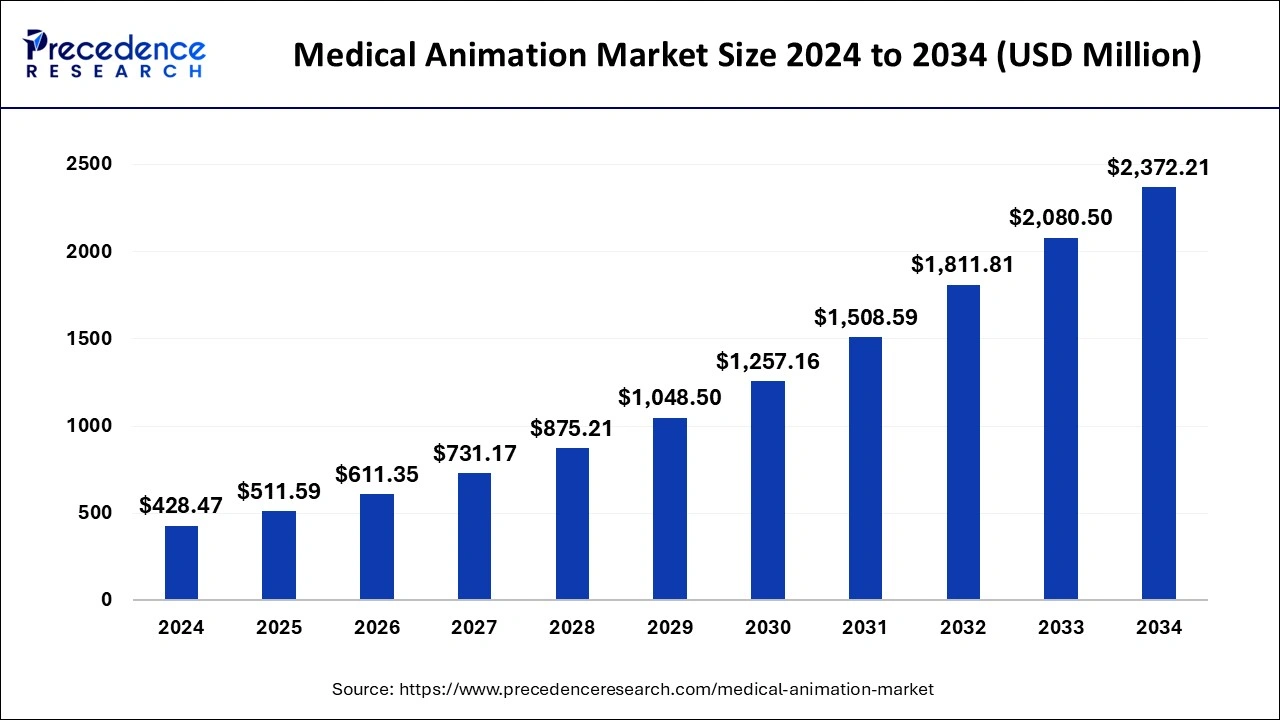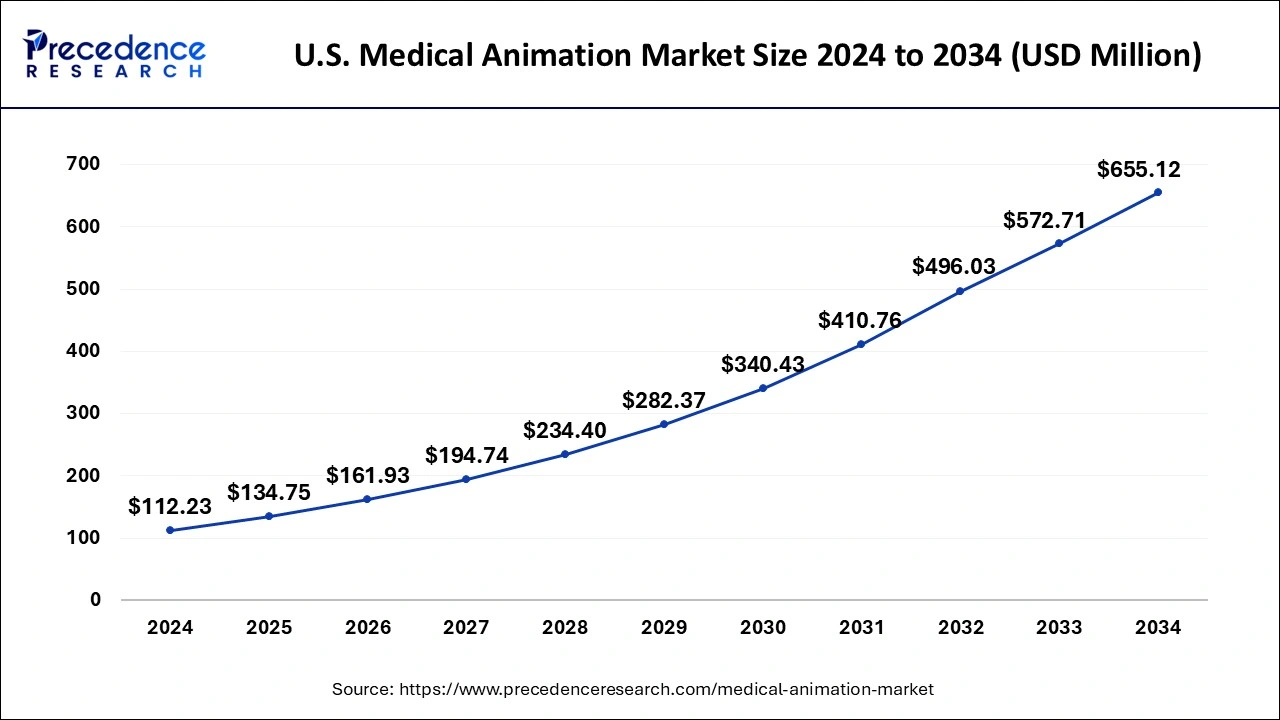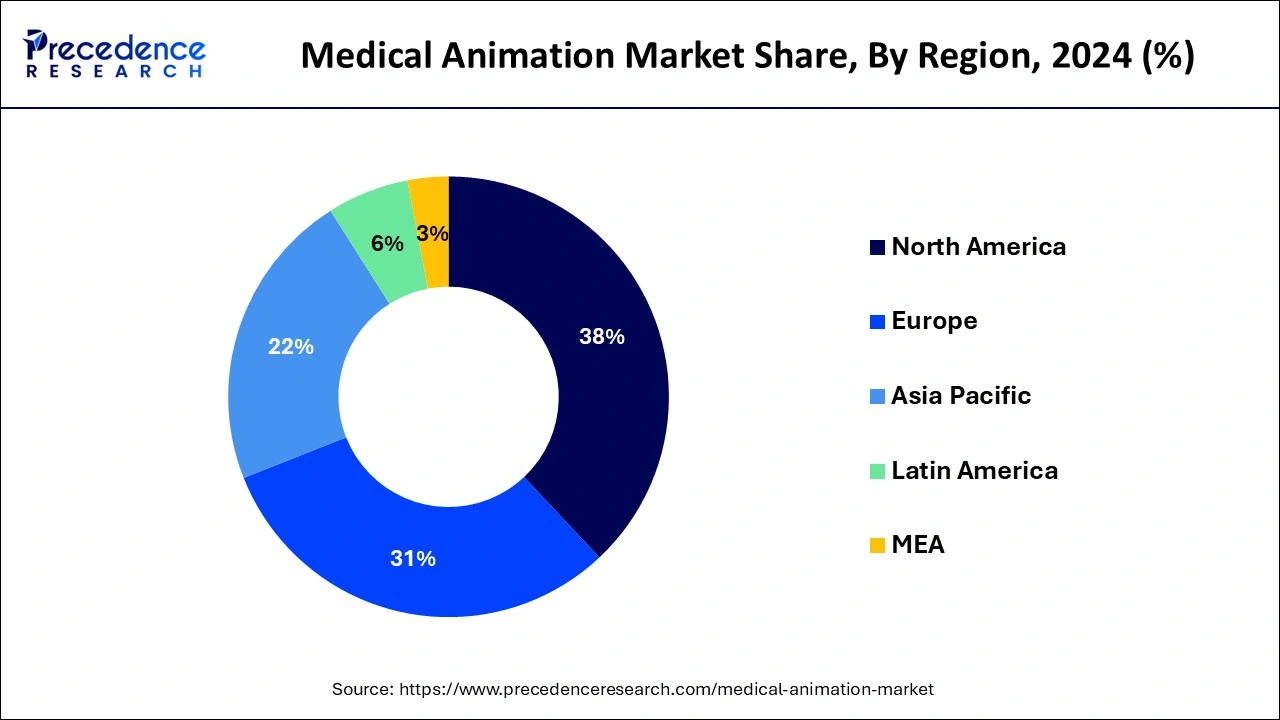January 2025
The global medical animation market size is evaluated at USD 511.59 million in 2025 and is forecasted to hit around USD 2,372.21 million by 2034, growing at a CAGR of 18.67% from 2025 to 2034. The North America market size was accounted at USD 162.82 million in 2024 and is expanding at a CAGR of 18.70% during the forecast period. The market sizing and forecasts are revenue-based (USD Million/Billion), with 2024 as the base year.
The global medical animation market size accounted for USD 428.47 million in 2024 and is predicted to increase from USD 511.59 million in 2025 to approximately USD 2,372.21 million by 2034, expanding at a CAGR of 18.67% from 2025 to 2034.

The U.S. medical animation market size was exhibited at USD 112.23 million in 2024 and is projected to be worth around USD 655.12 million by 2034, growing at a CAGR of 19.29% from 2025 to 2034.

North America has held the largest revenue share of 38% in 2024. North America holds a major share in the medical animation market due to its advanced healthcare infrastructure, significant investments in medical research and development, and a robust presence of pharmaceutical and biotechnology companies. The region's emphasis on cutting-edge technologies, coupled with a high level of awareness and acceptance of medical animation in healthcare and education, contributes to its market dominance. Additionally, strong collaborations between animation studios and healthcare institutions further drive the adoption of medical animation, solidifying North America's leading position in the global market.
Asia-Pacific is estimated to witness the highest growth. Asia-Pacific holds a significant share in the medical animation market due to several factors. The region's burgeoning healthcare industry, rapid technological advancements, and increasing healthcare awareness contribute to the demand for visually engaging and educational tools like medical animation. Additionally, the rising prevalence of chronic diseases, coupled with the expansion of medical education and research initiatives, propels the adoption of these visualizations. The presence of a large and diverse population, along with a growing number of healthcare institutions, further fuels the demand for medical animation services in the Asia-Pacific region.

Medical animation is a specialized form of visual communication that utilizes computer-generated imagery (CGI) to depict complex medical and biological concepts in a visually engaging and accessible manner. This dynamic tool is employed in various healthcare contexts to aid in education, training, and communication. By transforming intricate medical information into vivid 3D animations or simulations, medical animators facilitate a clearer understanding of anatomical structures, physiological processes, and medical procedures.
In the realm of healthcare, medical animation serves as a powerful resource for explaining intricate concepts to patients, students, and professionals alike. It is extensively used in medical training programs, patient education materials, and presentations for healthcare professionals. Through realistic and interactive depictions, medical animation not only enhances comprehension but also contributes to more effective communication within the medical community, ultimately fostering improved patient outcomes and advancing medical knowledge. As technology continues to advance, the role of medical animation is expected to expand, offering innovative ways to visualize and convey complex medical information.
| Report Coverage | Details |
| Growth Rate from 2025 to 2034 | CAGR of 18.67% |
| Market Size in 2025 | USD 511.59 Million |
| Market Size by 2034 | USD 2,372.21 Million |
| Largest Market | North America |
| Base Year | 2024 |
| Forecast Period | 2025 to 2034 |
| Segments Covered | Type, Therapeutic Area, Application, and End User |
| Regions Covered | North America, Europe, Asia-Pacific, Latin America, and Middle East & Africa |
Driver
Biopharmaceutical industry growth and rise in minimally invasive procedures
The growth of the biopharmaceutical industry significantly fuels the demand for medical animation. As biopharmaceutical companies engage in extensive research and development activities, medical animation becomes a crucial tool for visualizing complex drug mechanisms, molecular interactions, and clinical trial processes.
The intricate nature of biopharmaceutical advancements necessitates clear and accessible communication, making medical animation instrumental in conveying scientific concepts to diverse stakeholders, including researchers, investors, and regulatory bodies. This increasing reliance on medical animation enhances its market demand, as it plays a pivotal role in expediting understanding and decision-making processes within the dynamic biopharmaceutical sector.
Simultaneously, the rise in minimally invasive procedures amplifies the demand for medical animation in the healthcare landscape. As medical practices increasingly adopt minimally invasive techniques, there is a growing need for detailed visualizations that aid in preoperative planning, surgeon training, and patient education. Medical animation provides a comprehensive and interactive platform to showcase the intricacies of these procedures, fostering better comprehension among healthcare professionals and patients alike. This surge in demand is driven by the unique ability of medical animation to enhance learning, improve procedural outcomes, and contribute to the overall advancement of medical practices in the era of minimally invasive interventions.
Educational barriers and resistance to change
Educational barriers and resistance to change present significant restraints for the medical animation market. Limited access to educational resources and formal training programs on medical animation within academic institutions can impede the understanding and utilization of this technology among healthcare professionals. The lack of comprehensive education hinders the ability of practitioners to fully leverage medical animations for patient communication, procedural planning, and professional development. Resistance to change within the healthcare industry poses another challenge.
Some healthcare professionals may be hesitant to incorporate new technologies like medical animation into their practices due to unfamiliarity, skepticism, or concerns about disrupting established workflows. Overcoming this resistance requires targeted efforts to educate professionals about the benefits of medical animation, demonstrating its value in improving patient outcomes, enhancing communication, and advancing medical education. Addressing both educational gaps and resistance to change is essential for fostering broader acceptance and integration of medical animation into mainstream healthcare practices.
Opportunity
3D printing integration and augmented reality (AR) for surgical navigation
The integration of medical animation with 3D printing and augmented reality (AR) for surgical navigation presents transformative opportunities in the medical animation market. Collaborating with 3D printing technologies allows medical animations to be translated into tangible, anatomically accurate models. This integration is invaluable for surgical planning, medical training, and patient education, offering a tactile dimension that enhances the understanding of complex anatomical structures and procedures. The combination of 3D printing and medical animation creates a powerful synergy, enabling healthcare professionals to visualize and interact with physical models derived from animated representations.
Furthermore, augmented reality in surgical navigation introduces a new frontier for medical animation. By overlaying animated visualizations onto a surgeon's field of view during procedures, AR enhances precision and decision-making. Surgeons can receive real-time guidance and information, improving accuracy and reducing risks. This application not only streamlines surgical workflows but also exemplifies how medical animation, when integrated with cutting-edge technologies, can revolutionize the field of healthcare by providing dynamic, interactive support for medical professionals in critical moments.
In 2024, the 3D animation segment held the highest market share of 45% based on the type. The 3D animation segment in the medical animation market refers to the creation of three-dimensional, lifelike visualizations of medical concepts, procedures, and anatomical structures. This dynamic form of animation enables a realistic representation of complex biological processes, enhancing educational and communicative experiences in healthcare. Trends in the 3D animation segment involve a shift towards more interactive and immersive content, such as virtual reality (VR) integration, allowing users to engage with medical scenarios in a more experiential manner, fostering a deeper understanding of intricate medical concepts and procedures.
The flash animation segment is anticipated to witness highest growth at a significant CAGR of 20.4% during the projected period. Flash animation, a traditional but versatile type in medical animation, involves creating animated content using Adobe Flash software. It's characterized by its vector-based graphics, allowing for smooth and interactive animations.
In the medical animation market, flash animations are used to illustrate physiological processes, medical procedures, and drug mechanisms. Despite the declining popularity of Flash due to technological advancements, its simplicity and accessibility have led to its continued use in educational modules and presentations, especially in contexts where more complex rendering tools may not be necessary. The trend indicates a gradual shift towards newer technologies, but Flash remains relevant for specific applications in medical education.
According to the therapeutic area, the oncology segment held a 36% revenue share in 2024. In the medical animation market, the oncology segment focuses on visualizing complex concepts related to cancer, including tumor biology, treatment mechanisms, and surgical procedures. As a prominent trend, there is an increasing demand for detailed and dynamic animations in oncology to aid healthcare professionals, patients, and researchers in understanding the intricacies of cancer therapies, personalized medicine approaches, and the latest advancements in oncological procedures. The evolving landscape of cancer research and treatment continually drives the need for innovative and informative medical animations within the oncology therapeutic area.
The cardiology segment is anticipated to witness highest growth over the projected period. In the medical animation market, the cardiology segment focuses on visualizing complex cardiovascular concepts, diseases, and procedures. This includes animations illustrating heart anatomy, surgical interventions, and medical device mechanisms.
A prominent trend in cardiology medical animation involves the increasing use of three-dimensional visualizations to depict intricate cardiac structures, enhancing educational content for both healthcare professionals and patients. The evolving landscape of cardiovascular treatments and the demand for detailed educational materials contribute to the growth of medical animation within the cardiology therapeutic area.
According to the application, the drug mechanism of action (MOA) and approval segment held a 44% market share in 2024. In the medical animation market, the "drug mechanism of action (MOA)" segment involves visualizing the intricate processes by which pharmaceutical compounds exert their therapeutic effects within the human body. Medical animations play a crucial role in elucidating MOAs, aiding in both research and educational contexts.
The "Approval" segment pertains to animations illustrating the regulatory approval processes, including clinical trial phases and submissions to regulatory bodies. Trends in these segments include a growing demand for detailed MOA visualizations to aid drug development and an increased focus on creating regulatory-compliant animations for transparent communication during approval procedures.
The surgical training and planning segment is anticipated to witness the highest growth over the projected period. Within the medical animation sector, the segment focused on surgical training and planning involves crafting immersive visuals essential for preparing and honing surgical skills. Surgeons employ animated simulations to practice procedures, grasp intricate anatomical details, and elevate their techniques. Current industry trends underscore an increasing emphasis on incorporating virtual reality (VR) and augmented reality (AR) technologies, providing more interactive and lifelike experiences. This application not only enhances surgical precision and mitigates risks but also marks a noteworthy progression in advancing surgical education through a dynamic and effective platform for training and planning.
According to the end-user, the life science companies segment held a 25% revenue share in 2024. Life science companies form a crucial end-user segment in the medical animation market, encompassing pharmaceutical, biotechnology, and medical device firms. These companies leverage medical animation to visualize complex biological processes, drug mechanisms, and medical devices, aiding in research, development, and marketing.
A prominent trend in this segment involves an increasing demand for personalized and interactive animations to communicate scientific concepts effectively. As life science companies strive for innovation, the integration of cutting-edge medical animation technologies continues to be instrumental in enhancing communication within the industry and with diverse stakeholders.
The academic institutes segment is anticipated to witness the highest growth over the projected period. In the medical animation market, the academic institutes segment comprises educational institutions, medical schools, and training centers. These entities utilize medical animations as pedagogical tools to enhance learning experiences for students studying medicine, nursing, and related disciplines.
A key trend in this segment involves the integration of medical animation into academic curricula, providing students with visual and interactive educational resources. As technology advances, academic institutes are increasingly incorporating medical animations to facilitate a comprehensive understanding of complex medical concepts, procedures, and anatomical structures, contributing to the overall advancement of medical education.
By Type
By Therapeutic Area
By Application
By End User
By Geography
For inquiries regarding discounts, bulk purchases, or customization requests, please contact us at sales@precedenceresearch.com
No cookie-cutter, only authentic analysis – take the 1st step to become a Precedence Research client
January 2025
March 2025
August 2024
January 2025